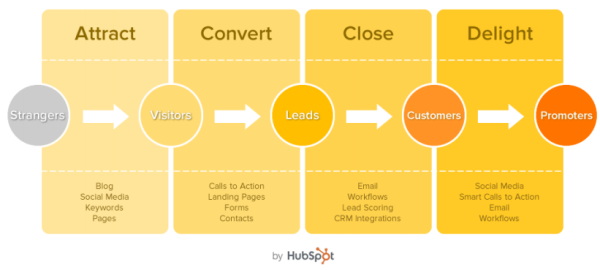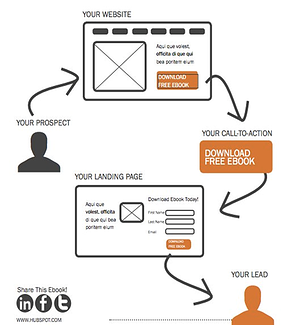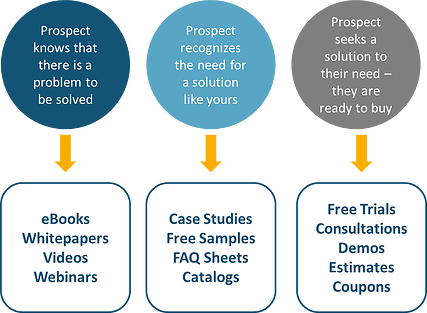 Let's get back to the basics. You may have heard the term inbound marketing, but aren't sure exactly what it means. Other terms used to describe the same set of processes include digital marketing, web marketing, internet marketing and social media marketing. Inbound marketing software provider HubSpot created the image below to describe the inbound marketing process.
Let's get back to the basics. You may have heard the term inbound marketing, but aren't sure exactly what it means. Other terms used to describe the same set of processes include digital marketing, web marketing, internet marketing and social media marketing. Inbound marketing software provider HubSpot created the image below to describe the inbound marketing process.

Technology has shifted control of the buying process from the seller to the buyer
Before going into more detail on what inbound marketing is, let's explore the circumstances that caused inbound marketing to displace tradtional outbound marketing techniques (telemarekting, direct mail, advertising and unsolicited email) as the most effective means of selling goods and services. Quite simply, technology has changed the buying process. The internet has shifted control of the buying process from the seller to the buyer. 20 years ago, buyers met with sellers to learn the benefits and features of the seller's prodcuts. There's no need to meet with a vendor to learn benefits today; all of that information should be available on the seller's website. If it isn't, good luck! The Corporate Executive Board provides evidence in the fundamental change in the modern buying process: they found that 57% of the buying process is complete before a buyer interacts with potential vendors.
Technology lets buyers turn off interruption marketing
Technology not only let's the buyer research purchase options on their terms, it allows them to ignore interruption marketing. 20 years ago, buyers would answer that dinnertime phone call because they didn't want to miss important calls from friends, family and associates. With the advent of voicemail and caller ID, this is no longer necessary. Annoying telemarketing calls go to voicemail and are deleted within 3 seconds. Unsolicited email suffers the same fate - the reader scans the headline and decides to read or delete within 3 seconds. Busy business people are more likely to hit the delete button than to read the email. Inbound marketing turns the tables on traditional marketing by attracting buyers to their marketing rather than shoving it down their throats.
The first step of inbound marketing - attract visitors to your website
In the modern buying process, buyers research potential purchase options through search engine queries and social media. They also rely on recommendations from trusted friends and colleagues. The first step of inbound marketing is to make sure that buyers find you when they're doing pre-purchase research. Keyword and search engine optimization strategies facilitate your website getting found for those important keyword phrases potential buyers use when researching the problems that your company solves. Blogging on topics of interest to your potential buyers is a positive signal to Google that your website provides good information for those search queries. This in turn increases the amount of traffic to your website.
Step 2 - convert website visitors to leads
Gleanster found that 90% of visitors coming to your website aren't ready to buy when they first come to your website. They're doing pre-purchase research. But many of them will eventually buy from somebody. The next step of inbound marketing is to convert visitors to leads. A website visitor becomes a lead by exchanging contact information (usually an e-mail address) in exchange for a premium content offer like an eBook, whitepaper, or a video. This contact infomation gives you the permission to nurture your lead through an opt-in email marketing process. Here is a graphic of the inbound lead generation process.

Step 3 - convert leads to customers
Many sales and marketing professionals will see that this process is a variation of the traditional sales funnel that we've seen forever. We start by attracting visitors to the top of the funnel and draw them further down the funnel by converting visitors to leads. The next step of the inbound marketing funnel is to convert leads to visitors. The ultimate goal of this process is to convert online relationships to personal relationships with your sales professionals. Lead nurturing is an email marketing process that provides the right kind of information to your leads as they move through their buying process. Here's a graphical representation of matching information to the different stages of a simple buying process.

You'll note that the ultimate goal of lead nurturing is to faciliate a meaningful conversation between your sales professionals and leads that are ready to buy. As a sales professional, you can't ask for much more than that!
The final step - create promoters for your solution with satisfied customers
Many companies stop here - they view the sale as the ultimate goal and move on to the next one. This is a short-sighted approach. In Google's Zero Moment of Truth study, buyers were asked what research sources they relied upon when making a purchase decision. 2 sources stood above the others - search engine queries and recommendations from friends, family and colleagues. If you're not delighting your customers with a world-class service experience, you're ignoring a key revenue generation strategy. There's no more powerful advertisement than an unsolicited recommendation from a customer on social media.
Summary
Inbound marketing produces results because it matches your sellling process with the modern buying process. While we don't advocate ditching traditional outbound marketing entirely, we do advocate for an integrated marketing strategy that infuses the inbound marketing philosophy throughout your organization. Inbound marketing is a tool and like any tool, it needs to be used skillfully to produce results. One of the key benefits of inbound marketing is that you can measure the results of anything you can do. Implement your inbound marketing plan and use analytics to foster continuous improvement.









